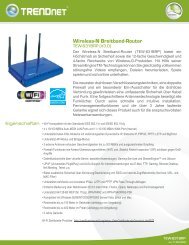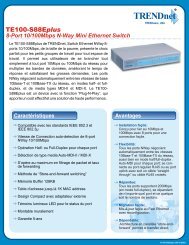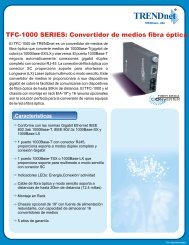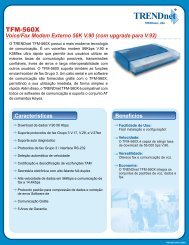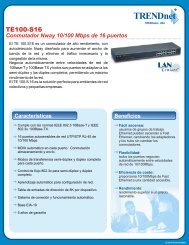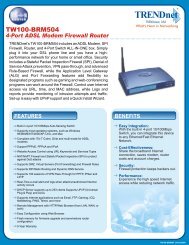Create successful ePaper yourself
Turn your PDF publications into a flip-book with our unique Google optimized e-Paper software.
Glossary (Continued)<br />
MIMO<br />
OFDM<br />
Packet<br />
Repeater<br />
Reverse SMA<br />
SMA<br />
SSID<br />
Term Definition<br />
MIMO (Multiple Input Multiple Output) is an antenna technology that uses multiple antennas to minimize<br />
errors and optimize data speed.<br />
OFDM (Orthogonal Frequency Division Multiplexing) splits the radio signal into multiple smaller<br />
sub-signals that are then transmitted simultaneously at different frequencies to the receiver.<br />
As a result, large amounts of digital data are transferred over a radio wave. OFDM also<br />
reduces the amount of crosstalk in signal transmissions.<br />
A unit of data sent across a network. When a large block of data is to be sent over a network,<br />
it is broken up into several packets, sent, and reassembled at the other end. Packets often<br />
include checksum codes to detect transmission errors. The exact layout of an individual packet<br />
is determined by the protocol being used.<br />
A device (e.g. wireless access point) used in wireless networks to extend wireless coverage by<br />
strengthening or repeating <strong>Wi</strong>-<strong>Fi</strong> signals.<br />
Reverse SMA (also known as Reverse Polarity SMA) is like an SMA connector, but the internal<br />
sex is reversed. For example, in a connector where a male pin would normally be present a<br />
female receptacle is found.<br />
SMA (Sub-miniature Type A) is a commonly used RF/Microwave connector. It's standard<br />
design interconnects to 12.4 GHz.<br />
A SSID (Service Set Identifier) is a 32-character alphanumeric key that uniquely identifies a<br />
wireless LAN. It is often referred to as the “Network Name”. It is used to keep unauthorized<br />
wireless equipment from accessing your LAN. To communicate, wireless devices on the same<br />
network must be configured with the same SSID.<br />
Turbo Mode Turbo Mode allows an access point to transmit wireless signals at 108Mbps.<br />
WEP<br />
WPA<br />
WEP (<strong>Wi</strong>red Equivalent Protocol) is a security protocol used to encrypt data transmitted over<br />
a wireless network. WEP has three settings: Off (no security), 64-bit (weak security), 128-bit<br />
(a bit better security). WEP uses four encryption keys that can be changed periodically to<br />
make traffic more difficult to intercept. All devices on the network must use the same<br />
encryption (keys).<br />
WPA (<strong>Wi</strong>-<strong>Fi</strong> Protected Access) is a higher level of security than WEP that combines<br />
encryption and authentication to create an unbreakable level of protection. A WPA-PSK (WPA<br />
Pre-shared Key) is set up on each network device, so that packets sent over a wireless<br />
network are encrypted using TKIP (Temporal Key Integrity Protocol).<br />
XR XR (eXtenderd Range) allows a wireless access point to provide better wireless coverage,<br />
eliminating indoor dead spots.<br />
v2.0906<br />
<strong>TRENDnet</strong> <strong>Wi</strong>-<strong>Fi</strong> <strong>Tutorial</strong> 14



